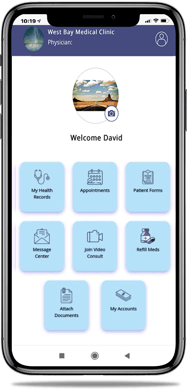What is a Patient Portal?
Patient portals offer numerous benefits to patients, but one of the most significant benefits is the ability to access their personal health information conveniently and securely.

A patient portal is a secure online platform that allows patients to access their health information, communicate with healthcare providers, schedule appointments, and manage their medical records efficiently. With a patient portal, patients can be in control of their own health and care. Patients log into patient portals using a user name and their own chosen password to ensure that only they have access to their health information.
Many medical practices have an integrated patient portal with their EHR system, which includes convenient mobile apps, text messaging, and secure, encrypted email. They allow the medical team to send messages such as appointment reminders, electronic statements, and lab results to patients. Patient data is exchanged between patients and the care team through a patient portal in an entirely HIPAA-compliant, secure fashion.
Functionality Offered by Patient Portals
Patient portals are designed around the central theme of enhancing patient-provider communication and increasing patient engagement. The security and convenience of a patient portal encourage patients to collaborate with their healthcare providers and to take a more active role in their health outcomes. Core features found in most patient portals provide patients the ability to securely view and print portions of their health records, including:
- Secure messaging between the provider and patients
- Record of recent provider visits
- Review discharge summaries
- Accessing and requesting prescriptions and prescription refills
- View and print immunization record
- View and print any allergies
- Provide access to most lab test results
In addition to the standard core features provided by Patient Portals, several additional features allow patients to further engage with their care teams and with relevant and required administrative and clinical functions. These additional features of a Patient Portal may include:
- Scheduling, changing, and confirming non-urgent medical appointments
- Downloading, completing, and electronically submitting required pre-visit and intake forms
- Reviewing medical insurance benefits and coverage options
- Making co-payments, co-insurance, or other related medical payments
- Updating medical history and reviewing relevant, patient-specific educational materials and information
- Downloading or completing intake forms
- Updating contact information
Benefits of Patient Portals
A Patient portal significantly increases patient engagement, decreases costs, and results in positive patient health outcomes, among other benefits listed below.
1. Improves patient communication
Patient portals allow patients to self-manage scheduling and administrative tasks that traditionally require direct communication, such as a phone call or office visit, on their own time and at their convenience. This lets the provider team focus on the needs of patients who need in-person care, improving medical staff efficiency.
2. Increases efficiency and reduce cost
Patients can complete routine transactions, including scheduling appointments, paying bills, and prescription refills on the patient portal, reducing the need for phone calls to the office. By using the portal to send regular automated appointment reminders, providers can see a reduction in missed appointments by their patients.
3. Streamlines front office workflow
Patient portals give healthcare providers more significant control of their most precious asset: Time. The resources and tools provided by a patient portal allow the most time-consuming processes, including completing in-take forms, gathering health insurance information, and completing required consent forms, to be completed electronically and submitted before arriving for a scheduled appointment.
4. Improves clinical outcomes
Patient portals give healthcare providers the resources to quickly send patients important reminders, share test results, provide prescription refills, and engage patients in online conversations during regular office hours, allowing you and your entire healthcare team to provide better, more responsive care to your patients.
5. Decreases overhead costs and increases revenues
Patient portals support the continued shift toward value-based reimbursement, more personal patient interaction, and increased patient engagement by allowing healthcare providers to utilize portal features to automate essential communications, such as reminders for annual preventative care appointments and upcoming scheduled appointments. Patient portals are also increasingly used to automate and send electronic patient billing statements, reminders, and payment options.
Healthcare practices using patient portals consistently demonstrate higher patient payment yield rates while increasing patient loyalty and return rates, which translates into increased revenue for your practice.
6. Provides convenient 24/7 access to the provider team
Patients can access their secure personal health information and contact their provider's office 24 hours daily. Patients do not need to wait for office hours or return phone calls to have fundamental issues resolved.
7. Provides secure access to health records
The ability to quickly and easily access their complete health records gives patients the ability to be more engaged with, and better manage, their health. Using a patient portal, a patient is able to use one secure location to store healthcare records and data and connect all of their healthcare providers to this information for a more streamlined, collaborative user experience.
8. Allows easy scheduling of appointments
Patients using a patient portal can quickly and efficiently schedule their appointment that works with their schedule and from a computer, tablet, or smartphone, saving time for both the patient and the front office of the provider.
9. Saves patients time and effort
The ability to electronically complete and submit intake, consent, and other required forms saves patients significant time and effort. Filling out these necessary completed forms in the patient portal saves time, reduces patient frustration, and improves the overall patient experience.
10. Increases communication with healthcare providers
Providing patients with multiple ways to communicate and allowing them to select their preferred method encourages patients to reach out to their healthcare providers for medical advice or with concerns through secure email, text, phone, or chat features.
If patients work with a team of providers or see specialists regularly, they can review results and reminders from all of them in one single patient portal. Providers can also see what other treatments and advice the patient is getting. This can lead to better care and better management of patients' medicines.
How Can Patient Portals Increase Patient Engagement?
Improved health outcomes and patient satisfaction can be achieved by engaging patients in the delivery of health care. Patient portals increase communication between healthcare providers and patients and serve to bridge the patient-provider gap when ensuring a true partnership that results in improved quality of care, improved patient outcomes, and increased patient satisfaction with their healthcare experience.
Patient portals may enhance patient engagement by:
- Enabling patients to access their electronic medical records (EMRs) and facilitating secure patient-provider communication.
- Making portals engaging and user-friendly, supporting patient-centered outcomes and integrating them into clinical encounters so the care team uses it to convey information, communicate with patients, and support self-care and decision-making as indicated.
How to Optimize Your Patient Portal?
Fully optimizing your patient portal ensures your practice is taking essential steps to improve patient engagement and patient satisfaction while improving your office’s workflow and efficiency. Ensure your office’s patient portal is optimized by taking the following steps:
- Create specific patient-directed messaging specific to the patient population served by your practice. Clear messaging, direct communication of procedures and required steps, and easy to understand information provided through your patient portal communicates a clear message of professionalism, care, and concern to your patients.
- Identify a clear strategy and point of contact to manage the patient portal enrollment process. The initial patient onboarding and education process is the most important step in transitioning your patients to the patient portal; once comfortable using it, most patients will turn to it to communicate with your healthcare providers, schedule non-urgent appointments, and review and pay their medical bills.
- Customize the content of your portal. Patients desire value-based care from their healthcare providers; the same holds when using a patient portal. Patients are much more likely to access and use your portal when they realize the value it provides to them; features like regularly updated and relevant patient or condition-specific educational materials, responsive messaging and communication, and ease of use matter to your patients and should be critical features of your patient portal.
Best Practices to Implement Patient Portal
Effective implementation of a patient portal is essential to the success of your practice’s patient engagement efforts. When planning the successful role out of your patient portal, it’s necessary to :
- Establish clear patient portal goals and priorities: Ensure your practice understands the intent of implementing a portal - including goals and expectations for patients and providers.
- Identify critical features and benefits you desire in a patient portal: Portals have hundreds, sometimes thousands, of features available to support your practice, but using all of them could be overwhelming and unnecessary. Take time to determine your practice's most critical patient portal features and benefits.
- Ensure Ease of Use: Patients expect a user-friendly, efficient, fast, and easy-to-use portal.
- Be Responsive: Office staff must be trained and ready to quickly respond to patient portal requests for appointment changes, prescription refills, medical questions, or additional care information.
- Develop a strategic plan to roll out your patient portal to your patients; this includes patient-specific strategies designed to introduce, enroll, educate, manage, and retain.
How can GenAI improve Patient Portals?
Using Generative AI can offer several opportunities to improve patient portals in various ways:
-
Personalization: AI can analyze patient data to personalize the portal experience, offering relevant content and services based on individual health needs and preferences.
-
Natural Language Processing (NLP): Implementing NLP can enhance communication through chatbots or virtual assistants, providing immediate responses to patient queries and facilitating appointment scheduling or medication refills.
-
Data Insights: AI can analyze patient feedback and usage patterns to provide insights that improve portal usability and functionality, ensuring it meets patient needs effectively.
-
Predictive Analytics: Utilizing AI for predictive analytics can anticipate patient needs, such as appointment reminders or preventive care recommendations, enhancing proactive healthcare management.
-
Security Enhancement: AI-driven cybersecurity can bolster portal security, detecting and mitigating potential threats to patient data privacy.
-
Voice Recognition: Integrating voice recognition technology can enable hands-free navigation and interaction within the portal, improving accessibility for patients with disabilities.
-
User Experience (UX) Optimization: AI can analyze user behavior and preferences to optimize the portal's UX design, ensuring intuitive navigation and enhancing overall satisfaction.
Implementing Generative AI in these areas can significantly enhance the functionality, usability, and security of patient portals, ultimately improving the patient experience and healthcare outcomes.







